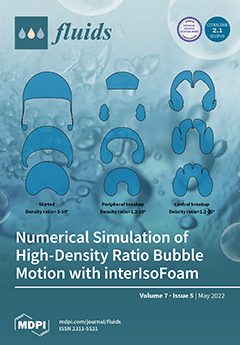The condition for the
formation of
droplet groups in liquid sprays is poorly understood. This study looks at a simplified model system consisting of two iso-propanol droplets of equal diameter,
, in tandem, separated initially by a center-to-center distance,
[...] Read more.
The condition for the
formation of
droplet groups in liquid sprays is poorly understood. This study looks at a simplified model system consisting of two iso-propanol droplets of equal diameter,
, in tandem, separated initially by a center-to-center distance,
, and moving in the direction of gravity with an initial velocity,
, where
is the terminal velocity of an isolated droplet from Stokes flow analysis. A theoretical analysis based on Stokes flow around this double-droplet system is presented, including an inertial correction factor in terms of drag coefficient to account for large Reynolds numbers (≫1). From this analysis, it is observed that the drag force experienced by the leading droplet is higher than that experienced by the trailing droplet. The temporal evolutions of the velocity,
, of the droplets, as well as their separation distance,
, are presented, and the time
at which the droplets come in contact with each other and their approach velocity at this time,
, are calculated. The effects of the droplet diameter,
, the initial droplet velocity,
, and the initial separation,
on
and
are reported. The agreement between the theoretical predictions and experimental data in the literature is good.
Full article





